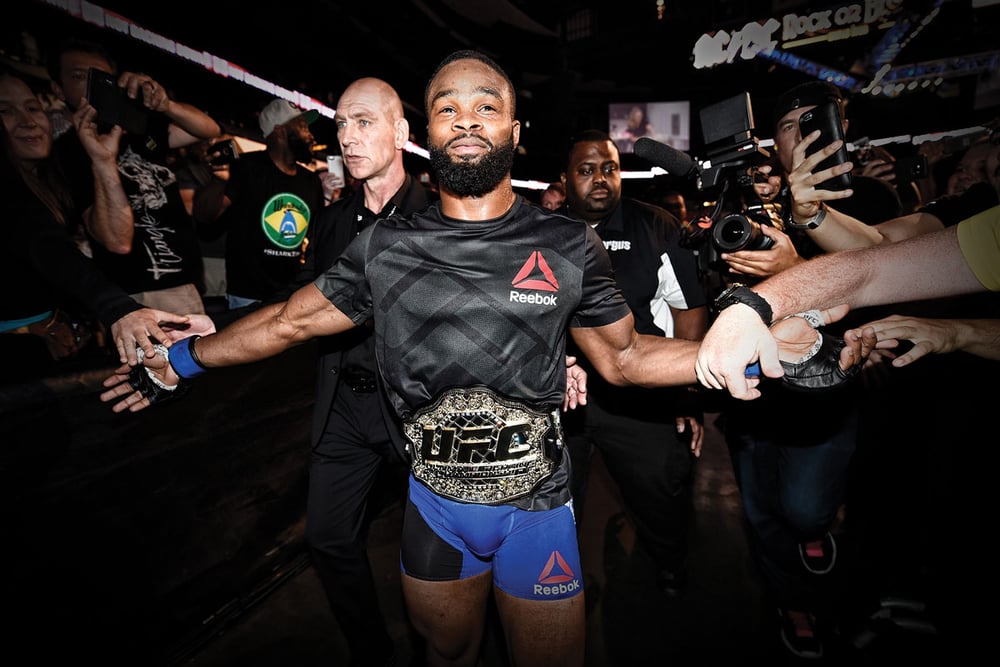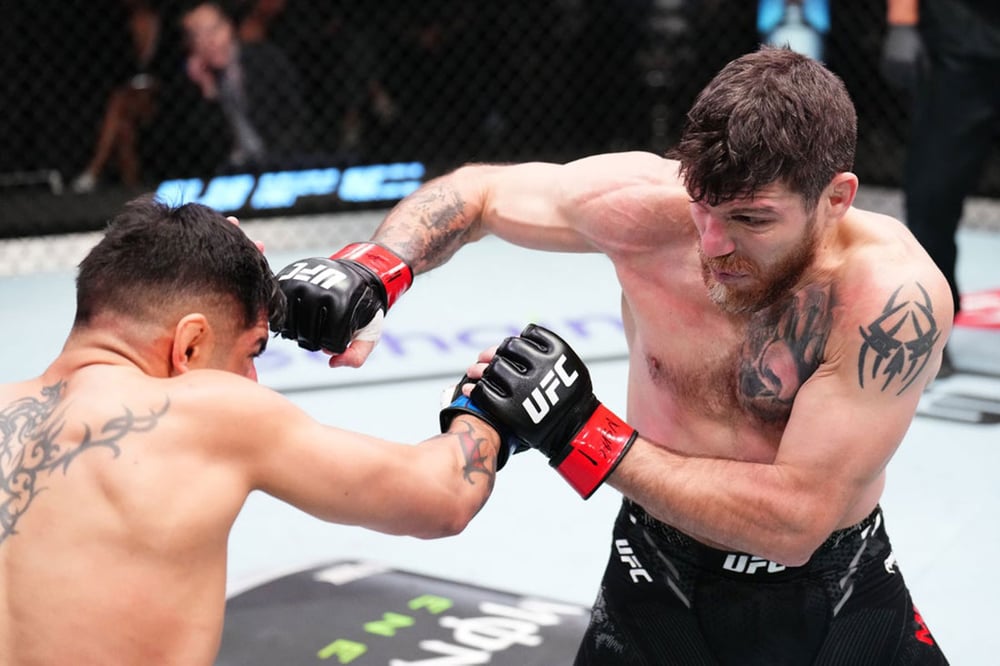
Issue 206
June 2024
We explore the challenges and benefits of elite MMA fighters competing past the age of 40.
There’s a cliche in combat sports that a fighter can grow old overnight. Without seeing the day-in and day-out of a training camp, it can feel like a lot changes suddenly as a mixed martial artist ages. Even with athletes having longer careers right now than ever, it’s still rare to see people step inside the cage over 40.
Kyle Dimond looks at the fighters who compete later in their careers than most, swapping their athletic prime for experience and wisdom.

FATHER TIME IS UNDEFEATED
It’s embedded into the head of a sports fan that an athlete is on the decline towards the end of their career. Such a physically demanding career path is not meant for people nearing the dreaded big 40, which goes for all sports. Of course, there are exceptions to this rule. Some outliers age like a fine wine, but they are exactly that: outliers. Sporting careers are getting longer over time thanks to better practices regarding recovery, supplements, and surgical procedures. This longevity is the case across the entire sporting world and is particularly relevant for a young sport like MMA. It has gone from a shunned underground cage fight to a prominent major player in thirty years. When you hear stories of how fighters trained even 15 years ago to now, it’s an entirely different level where fighters are now treating their bodies like professional athletes.
That said, fighting is still a young man’s sport for a reason. Even with the new science and technology out there for recovery, nothing can prevent the wear and tear of combat sports. You can’t expect to go swimming without getting wet, and in the same vein, you can’t practice martial arts without taking some damage along the way. There is certainly more awareness of CTE and how to preserve your body in the best way possible than before, but not sparring flat out every single day doesn’t change the fact that you’re getting into a car crash at the end of it. In addition to the damage that a fighter will accumulate over time, be it through trauma or injuries, training alone can be a considerable factor. An older fighter, especially one that has already been pushing themselves to the limit for years prior, will not have the same recovery. That means more time to get over injuries and less energy in training sessions, which can have a mental and physical impact.
THE 35 CURSE AND A MENTAL PRIME
Inside the cage, you will find most fighters in their mid to late thirties saying they feel better than ever or just like they did 10 years ago, but look across every form of athletic competition, and no one gets faster as they get older. In MMA, speed is as crucial as power, timing, and technique. It’s no fluke that in the welterweight division and below, fighters aged 35 and over in the welterweight division or lower have won just 2 out of 33 title fights.

Both exceptions to the “35 curse” were produced by Tyron Woodley in his consecutive title defenses against Demian Maia and Darren Till. At the same time, Alexander Volkanovski and Dustin Poirier recently found themselves on the wrong end of this statistic at UFC 298 and UFC 302.
Former UFC title challenger Chael Sonnen argues that there is a misconception about what a fighter being past their prime truly means. He says that someone losing their physicality, speed, and potentially their ability to withstand damage over time are all factors. Still, in his opinion, the mental side of the sport takes the biggest hit. Sonnen` spoke on this in a YouTube video in response to Urijah Faber returning to the UFC at 40 after retiring three years prior.
“The truth is, broad-stroke here, but over 90% of it’s mental. At some point in a guy’s career, he’s just done it enough. At some point in a guy’s career, he’s just not as motivated. At some point in a guy’s career where he’s hungry and has a big dream, eventually, he gets fed and that big dream has come true, so how do you get up and do it again?”
THE NUMBERS DON’T LIE
In an article written for MMA Fighting by Luke Thomas in 2012, he looked at how significant age is when attempting to predict a fight. At the time. 35-year-old Josh Koscheck was about to take on a rising 28-year-old contender in Johny Hendricks. Thomas uses statistics from FightMetric, now UFC Stats, to examine how age impacts winning percentage.
The statistics show that using 2600 fights as the sample pool, the younger fighter won 57% of the time (1489 victories). It also shows that the younger fighters secured more knockouts (61% - 559 fights) in their wins than anything else, while the predominant method for older fighters was via decision (46% - 430 fights), an excellent example of the athleticism vs experience factor. Another way to view the statistics is through a graph that charts how the win percentage for the younger fighter gradually increases depending on the age gap between the two competitors. Aside from one discrepancy, the winning percentage climbs from 50-50 for fighters of the same age to 70% in favor of fighters younger than their opponents by 10 years or more.
“The upward trend in the graph overall (with one lone exception) tells us age discrepancy matters.” Thomas writes. “It's also intriguing that even in cases where both fighters are considered 'young' - say 22 and 23 years old - the younger of the two still holds a statistical advantage.”
It is worth pointing out that these statistics are over 10 years old, but the point still stands even with athletes having extended careers as time goes on.
THE EXCEPTIONS TO THE RULE
Even with the clear statistical evidence showing that fighters older than their opponents are less likely to win, many still compete into their late thirties or even past the 40 mark. On the UFC’s recently announced card for Abu Dhabi alone, Tony Ferguson and Nick Diaz will walk on August 3rd as two over 40 fighters. Plenty have done it, but again, the standard perception is that they are less effective competitors than they were when they were younger. To look at the benefits of fighting later in a career, we must look at the outliers mentioned above. Acting as a counterweight to the wear and tear of years of training and competing is experience. Jim Miller, who is also in the 40 club, is undoubtedly a very tough and durable fighter with great grappling and power in his hands, which many will say is the last thing to leave a fighter. However, when you look at his ability to continue taking out rising prospects inside the Octagon, his experience as the athlete with the most UFC fights in history is the clear factor. In a sport as unpredictable as MMA, Miller has been there, done it, and soaked up the blood with the T-shirt.

Experience is precious, but if you look at all of the fighters who have achieved success over 40 at the highest level, they all tend to have one thing in common: their fighting style. Pick anyone from Randy Couture, Glover Teixeira, Jim Miller, Aleksei Oleinik, Demian Maia, or for the best possible example from the boxing world, Bernard Hopkins, who became a world champion at the staggering age of 48. This list purposefully excludes Yoel Romero because his career defies science and logic. None of these fighters relied on athleticism and speed to be effective. Over time, they used their experience and technical skill, prominently in grappling on the MMA side, to nullify any physical advantages their opponent may have.
DOING IT FOR THE OLD GUYS
Look at the oldest first-time UFC champion, Glover Teixeira, who became the light heavyweight champion at 42. When he first started training with UFC star Chuck Liddell and coach John Hackleman at the start of his career, they were impressed by how tough he was. Liddell even remarked during the UFC original series “FIGHTLORE” that if it was possible, Glover might enjoy fighting even more than he does. With some better technique added to his game, they saw the potential. Unfortunately, due to his inability to sign up for the UFC due to his long-running visa saga, Teixeira’s teammates worried that his best years would be wasted in Brazil, where he racked up fight experience.

Just like Randy Couture, who fought in the UFC until an incredible 47-years-old, Glover combined his toughness and work ethic with high-level grappling, which didn’t require him to be a supremely fast athlete, and all of the experience he had accumulated over time. The last three wins of his UFC career, where he finished top contenders in Anthony Smith, Thiago Santos, and champion Jan Blachowicz, all came past the 40 mark. In his incredible back-and-forth war with Jiri Prochazka, he lost the title in one of the best championship fights the Octagon has ever seen. Teixeira was the definition of a crafty and incredibly durable veteran who would rely on the strengths that never left him.
EXTENDING CAREERS IN THE RING
Ultimately, bar a few key expectations, fighters at the highest level don’t tend to age gracefully in their ability to compete. The damage they take when stepping inside the cage and in training camps comes with a heavy toll over time. With the rise of crossover boxing events, several high-profile names have looked to extend their careers by transitioning to the ring. While this brings some substantial pay cheques for fighters who have already made their names in MMA, it’s also less demanding on them.
That’s not to say that boxing training is easy on the body, but it won’t be as taxing without grappling being in the mix. On the flip side of this point, while MMA training still requires an athlete to take damage in sparring, moving to boxing at the end of their careers means they won’t have been taking as many consistent blows to the head day in and day out. Nate Diaz and Jorge Masvidal will be 39 when they meet in boxing on July 6th. For a further down-the-line example, Anderson Silva and Chael Sonnen were 49 and 47, respectively, when they met in an exhibition bout just this past month.
Masvidal stated after his last UFC fight, a loss to Gilbert Burns at UFC 287, that he wanted to retire if he could no longer compete with the best in MMA. Like most fighters, he hasn’t lost his passion for training and competing, as proven by his upcoming boxing match. He simply isn’t able to compete in MMA at the level that he would like to at this stage.
Over the next few months, this conversation of how long a fighter should compete will be a widespread debate across everything from boxing experts to workroom water coolers. There has arguably never been a more significant or controversial example of how much age and wear and tear play into a fight than when the 27-year-old Jake Paul was announced to be boxing Mike Tyson, who will be 58 by the time they finally meet in November. Despite the over three-decade age gap between them, the fight has been sanctioned as a professional bout. So can the body take it? The level of competition these bouts bring will be the judge while the world watches as a jury, but only the fighters can tell you if they'll be up for doing it again.










